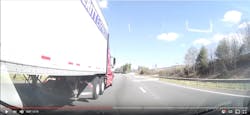Until blind-spot detection systems are perfected (almost-perfect doesn’t count, though it helps) and adopted, truckers will continue deal with the matter dozens, even hundreds of times a day: The mirror’s clear, but is anything there? And the resulting: How can it be my fault when I couldn’t see anything? But, fair or not, the trucker is usually blamed.
The issue is top-of-mind for the Dash Cam of the Week staff after we spent a lot time on a very busy I-40 recently. With a great many commercial vehicles on those long, flat stretches, you’re going to get some elephant races—and that’s going make for impatient four-wheelers. But really, how can they not understand that a truck driver will move back to right lane as soon as he’s cleared the rig he’s overtaking? But noooooo. Let’s just zip right around before he can come back, maybe flip off the truck driver for blocking the fast lane. And once one idiot does it, the line of cars behind tries to follow—although we never see it. (And we just can’t wait for that speed-limiter mandate … good times! Where’s that blood pressure pill?)
Anyway, blind spots. In this first clip, the limited before-and-after view makes us suspicious that the four-wheeler driver who posted it is hiding something—like maybe ignoring the truck’s turn signal. And he says in the comment section that there was a car coming up in the open lane to right, so he couldn’t move over and easily avoid the minor collision. (He did note that the truck driver stopped and came back.)
You’ll have to imagine the mirror image of this clip, since it comes from Britain. (Which also means the drivers are on the right, so the lorryman really couldn’t see the compact car beneath the cab window—but the four-wheeler driver gets a dangerously good view.) Our guess is the trucker is positioned to merge without swinging too wide into both lanes of the road, but hte small cars saw an opening and took it. Again, what’s a truck driver to do?
About the Author
Kevin Jones
Editor
Kevin has served as editor-in-chief of Trailer/Body Builders magazine since 2017—just the third editor in the magazine’s 60 years. He is also editorial director for Endeavor Business Media’s Commercial Vehicle group, which includes FleetOwner, Bulk Transporter, Refrigerated Transporter, American Trucker, and Fleet Maintenance magazines and websites.
Working from Beaufort, S.C., Kevin has covered trucking and manufacturing for nearly 20 years. His writing and commentary about the trucking industry and, previously, business and government, has been recognized with numerous state, regional, and national journalism awards.

